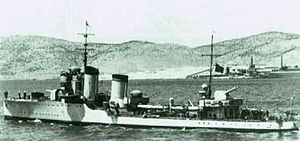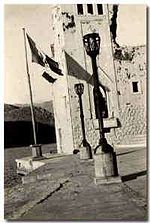- Operation Abstention
-
Operation Abstention Part of the Mediterranean Theater of the Second World War 
Italian destroyer CrispiDate 25-28 February 1941 Location Island of Kastelorizo, eastern Aegean Sea Result Italian victory Belligerents  United Kingdom
United Kingdom
 Australia
Australia Italy
ItalyCommanders and leaders  Admiral Andrew Cunningham
Admiral Andrew Cunningham
 Rear Admiral E. de F. Renouf
Rear Admiral E. de F. Renouf
 Captain H. J. Egerton
Captain H. J. Egerton Admiral Luigi Biancheri
Admiral Luigi Biancheri
 Captain Francesco Mimbelli
Captain Francesco MimbelliStrength 1 light cruiser
1 anti-aircraft cruiser
7 destroyers
1 gunboat
1 submarine
1 armed yacht
200 commandos
200 soldiers and marines2 destroyers
2 torpedo boats
2 MAS boats
SM.79 bombers
SM.81 bombers
240 soldiers
88 marinesCasualties and losses 5 killed
20 captured or interned
7 missing[1]
1 gunboat damaged14 killed
12 captured[2]U-boat Campaign – Club Run¹ –- Malta Convoys¹ –- Espero¹² – Mers-el-Kébir – Calabria¹² – Cape Spada – Cape Passero¹ – Taranto – Strait of Otranto² – White¹ – Cape Spartivento¹ – Excess¹ – Abstention – Souda Bay – Matapan – Tarigo² – Crete – Substance¹ – Halberd¹ – Duisburg² – Bon² – December 1941² – 1st Sirte¹² – Alexandria raid – 2nd Sirte¹ – Calendar – Harpoon¹ – Vigorous¹ – Pedestal¹ – Agreement – Torch – Stone Age¹ – Toulon – Portcullis¹ – Skerki² – Algiers¹ – Cigno² – Sicily – Olterra's campaign¹ – Sinking of Roma – Dodecanese Campaign – Cape Bougaroun¹ – Port Cros – La Ciotat¹ - Involved an Allied convoy • ² - Involved an Axis convoy
Operation Abstention was the code name given to the British invasion of the Italian island of Kastelorizo, off Turkey, during the Second World War, on late February 1941. The goal was to establish a pivotal base to challenge the Italian naval and air supremacy on the Dodecanese islands.[3]Contents
Background
After the attack on Taranto and the successful offensive of Cirenaica, Britain and its allies gained the upper hand along the Mediterranean. Confident that the neutralization of the Italian forces in the Dodecanese would be the next stage, the command of the Mediterranean Fleet planned the occupation of the tiny island of Kastelorizo, the easternmost of the chain, some 80 mi (70 nmi; 130 km) from Rhodes, to establish a motor torpedo boat base there.[4] The operation was intended as a first step towards the control of the whole Aegean Sea.[3][5] The Italians, however, were far from being on the brink of collapse. Their naval and aerial assets there were still capable of carrying out sporadic hit-and-run attacks on the Allied shipping between Egypt and Greece.[6]
The British landing
The leading force was composed by 200 commandos, who were transported by the destroyers HMS Decoy and Hereward. A 24-man detachment of Royal Marines was on board the gunboat HMS Ladybird. The flotilla sailed from Suda Bay on 24 February. The initial plan was to build-up a beachhead in the island for only 24 hours, before the arrival of a Sherwood Foresters company to consolidate the British garrison.[7] This second force would come from Cyprus on board the armed yacht HMS Rosaura and escorted by the light cruisers HMAS Perth and HMS Bonaventure. Before dawn, the commandos and the Royal Marines start the landing on the main port of the island, after the submarine HMS Parthian made a previous reconnaissance of the coast. The Italian presence at Kastelorizo consisted of a small and miscellaneous unit of soldiers and agents of the Guardia di Finanza in charge of a wireless station. The British troops took the garrison by surprise, seizing the radio outpost. Twelve of the servicemen were taken prisoners. Before the commandos could overrun them, the Italians sent an alert to Rhodes, the main Italian air and naval base in the Dodecanese. [6] Some Italian sources[8] claim that the British forces captured the Italian cryptography code, but this assertion is dismissed by the Italian author Marc’Antonio Bragadin, a high-ranking naval officer at the time.[9] British sources make no mention of such issue.
The Italian counter-attack
Only a few hours later, aircraft of the Regia Aeronautica (Italian Royal Air Force) appeared over the island. The bombers targeted the harbour, the castle, and the main hills of the small island where the commandos were entrenched. During one of these raids, HMS Ladybird was struck by a bomb, which resulted in three seamen wounded. The vessel, already short of fuel to continue her mission, was forced to reload the Royal Marines party and to make for Haifa. A consequence of the withdrawal of the gunship was the loss of the radio link of the commandos with Alexandria.[10]
The show of force by the Regia Marina (Royal Italian Navy) took place at sunrise on the 27th. The torpedo boats Lupo and Lince started the landing of about 240 soldiers north of the port, while their 3.9 in (99 mm) guns pounded the British positions,[6] specially the docks and the Governor's palace. Three commandos were killed and seven injured.[1] Meanwhile, HMS Hereward, warned by the commandos ashore of the Italian naval activity, decided then to join Decoy, at the time about 40 mi (35 nmi; 64 km) away from the coast. The Commander of the operation ordered the warships to disrupt the Italian landings, but the destroyer flotilla was unable to find the enemy warships. Hereward reported to the Commander-in-Chief that the Italian surface action would make extremely dangerous the landing of the main British force from Rosaura, already compromised by the air attacks on the harbour. Therefore, the garrison landing was postponed and rearranged. The disembarkment would be carried out by the destroyers Decoy and Hero, after transboarding the Sherwood Foresters company from Rosaura. All ships were ordered to Alexandria to complete the reschedule. To make things worst, Admiral Renouf was listed as sick and replaced by Captain Egerton, commander of HMS Bonaventure.[11] At the same time, the high seas also forced the Italian navy to suspend the landings until the morning of the 28th. The Italian forces already inland continued to harass the exhausted and isolated British commandos, who were equipped only for a 24-hour action.[6][12] The Italian squadron returned some hours later, reinforced with two destroyers from Leros, the Crispi and the Sella, and two MAS motor-launches, unloading the remainder of the land contingent and resuming the shelling. The pressure by air and sea made the British troops' situation untenable. Indeed, when the forces from Alexandria came in on the 28th, the company’s commander, Major Cooper, after conferencing with the other chiefs responsible for the operation, realized that without sustained naval and air support, the withdrawal was unavoidable. The bulk of the land forces, isolated on a small plateau in the easternmost point of Kastelorizo[1] was therefore reembarked. The Italian troops surrounded and eventually captured a number of commandos who were left behind. While providing protection to the retreat, HMS Jaguar was targeted by two torpedoes fired by Crispi, which failed to hit her. Jaguar responded with her 4.7 in (120 mm) guns, but the jamming of a searchlight prevented her from striking home. After this last fruitless action, the British force sailed back to Alexandria.[11] The destroyers HMS Nubian, Hasty and Jaguar—in a further sweep between Rhodes and Kastelorizo—were unable to intercept the returning Italian warships.[13]
Aftermath
The operation was described by Admiral Cunningham as "a rotten business and reflected little credit to everyone".[3] A Board of Inquiry found that Hereward's commander misjudgement of rejoining Decoy, instead of making contact with the enemy force without delay, was key to the failure of the main landing and the isolation of the commandos.[11] The British commanders were also surprised by the strong reaction of the Italians.[9][14]
The Italian military remained in control of the Dodecanese until the capitulation of its country in September 1943. As Italy now sided with the Allies, the British landed on the islands. British and Italian troops however were attacked and defeated by the Germans, and the islands came under German control, which lasted until the end of the war. Kastelorizo was not occupied, but constant air attacks destroyed many of the homes and forced the majority of the population to flee to neutral Turkey or to Allied-held Palestine.
Order of battle
Italy
- Admiral Luigi Biancheri
- 2 destroyers: Crispi, Sella
- 2 torpedo boats: Lupo, Lince
- 2 MAS motor launches: MAS-541, MAS-546
- Original garrison: 30 soldiers of the signal corps
10 carabinieri and Guardia di Finanza (custom agents) - Landing forces: 240 Infantrymen, 88 marines
Allies
- Admiral Andrew Cunningham
- Suda force:
- Cyprus force:
- 3rd Cruiser Squadron:HMAS Perth, HMS Bonaventure
- Armed yacht: HMS Rosaura
- Garrison force: Around 150 soldiers
- Alexandria force:
- 2 destroyers: HMS Jaguar, HMS Hero
See also
- Balkans Campaign
- Dodecanese Campaign
- Convention between Italy and Turkey, 1932
Notes
- ^ a b c Castelrosso: Fasti e declino di un'isola del Mediterraneo (Italian)
- ^ Smith & Walker, page 22
- ^ a b c Simpson, page 85
- ^ Greene and Massignani, p. 145
- ^ Koburger, pp 107-108
- ^ a b c d Bragadin, page 80
- ^ Seymour pp 69-70
- ^ Santoni, page 67
- ^ a b Sadkovich, page 119
- ^ Titterton, pp. 72-73
- ^ a b c Titterton, pp. 73-74
- ^ Seymour, page 70
- ^ www.naval-history.net/February 1941
- ^ Smith & Walker, page 32
References
- Bragadin, Marc'Antonio (1957). The Italian Navy in World War II, United States Naval Institute, Annapolis. ISBN 0405130317.
- Greene, Jack & Massignani, Alessandro (1998). The Naval War in the Mediterranean, 1940-1943, Chatam Publishing, London. ISBN 1861760574.
- Koburger, Charles W. Jr (1993). Naval Warfare in the Eastern Mediterranean (1940-1945). Praeguer Publishers, Westport. ISBN 0275944654.
- Sadkovich, James (1994). The Italian Navy in World War II. Greenwood Press, Westport. ISBN 1861760574.
- Santoni, Alberto (1981). Il Vero Traditore: Il ruolo documentato di ULTRA nella guerra. Mursia. (Italian)
- Seymour, William (1985). British Special Forces. Sidgwick and Jackson. ISBN 0283988738.
- Simpson, Michael (2004) A life of Admiral of the Fleet Andrew Cunningham. A Twentieth-century Naval Leader. Rutledge Ed. ISBN 0714651974.
- Smith, Peter & Walker, Edwin (1974). War in the Aegean. Kimber. ISBN 0718304225.
- Titterton, G.A. (2002). The Royal Navy and the Mediterranean. Routledge, London. ISBN 0714652059.
 British Commando raids of the Second World War
British Commando raids of the Second World WarA B C D E ExporterF G H Hardtack · Huckaback · Hawthorn · Houndsworth
I J K L M N P R Rimau · Roast · Roundabout · Rumford
S T British Commandos · List of Commando raids on the Atlantic wall Categories:- World War II British Commando raids
- Battle of the Mediterranean
- Battles of World War II involving Italy
- Battles of World War II involving the United Kingdom
- Naval battles of World War II involving Italy
- Naval battles of World War II involving the United Kingdom
- Conflicts in 1941
- Kastelorizo
- Admiral Luigi Biancheri
Wikimedia Foundation. 2010.


